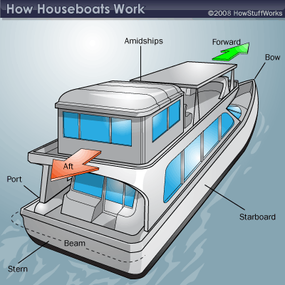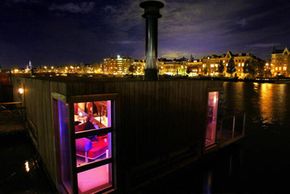Characteristics of a Houseboat
So what makes a houseboat a houseboat? Although everyone might have their own definition of what a houseboat is, it's exactly what it sounds like -- a house someone may own or rent that floats on water. It can be as simple as a small hut placed on top of a raft, or as lavish and intricate as a million-dollar home. Houseboats can be built brand-new by a manufacturer, or people can buy them used from someone wishing to part with their houseboat. The most ambitious liveaboards will go the distance and construct a houseboat entirely on their own.
There are two basic categories of houseboats:
Advertisement
- Non-cruising houseboats - These houseboats aren't meant for traveling out to sea and have very limited mobility (or none at all). They may have a small engine or a sail, but most of the time they are moored, anchored or tied up to a slip, or a designated spot, in a marina or dock. A non-cruising houseboat is the most common kind of floating home.
- Cruising, or "bluewater," houseboats - If a person wants to use his home for excursions, this type of houseboat is equipped for moving about on the water. Cruising houseboats will definitely have an engine or sails, so they'll rely much more on fuel for mobility.
If you were to look into purchasing a houseboat but haven't spent too much time onboard boats, you might have trouble understanding the terminology used to describe a houseboat's specifications. A houseboat is like any other floating vessel and uses much of the same nautical lingo as a yacht or a submarine does.

These are the structural terms used to describe the parts of a houseboat:
- Bow - The front of the boat (which usually comes to a V-shape)
- Stern - The back of the boat
- Forward - Moving toward the bow
- Aft - Moving toward the stern
- Port - If you're facing the front of the boat, the left side of the boat
- Starboard - If you're facing the front of the boat, the right side of the boat
- Amidships - The middle of the boat
- Beam - The widest part of the boat
- Draft - The depth of the boat
There are also several measurements important to liveaboards and marinas. The length of the boat is the hull length -- the space in which you can physically walk around. This number helps houseboat owners know how much living space they'll have inside their boat. The length overall (LOA), on the other hand, is the length of the entire boat, from the very back of the stern to the tip of the bow. This is important to someone running a marina, since it lets him know how much space the boat will take up at the dock. The draft of the boat, or how deep it goes, is important to know so the bottom doesn't scrape on rocks and cause any damage to the home.
For a look at the practical, day-to-day parts on a houseboat, see the next page.
